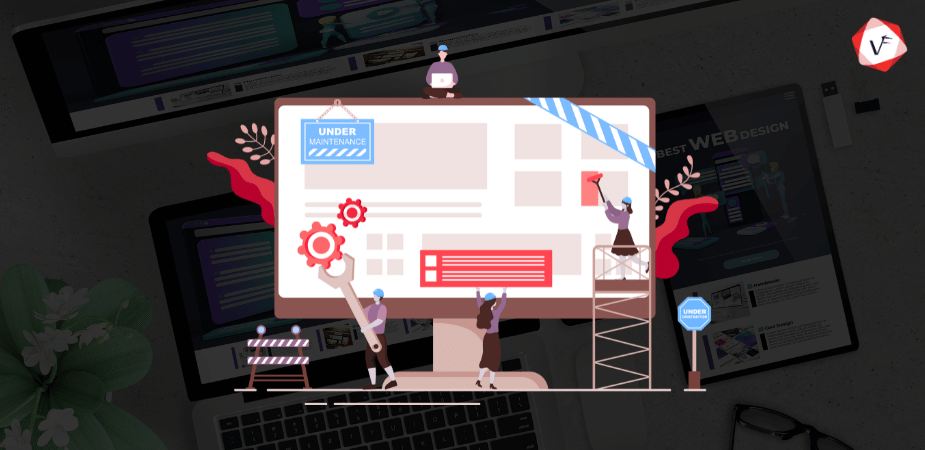Front End vs.Backend
In the developing world of web development, staying informed about the fundamental aspects is essential. Two crucial components that play an important role in crafting functional and user-friendly websites and applications are front-end and back-end development. These components have distinct roles, skill sets, and technologies associated with them. This blog aims to explore deep into the differences between front-end and back-end development, pointing out the critical aspects of each and the technologies that power them.
What is Frontend Development?
Frontend development, or client-side development, is related to everything the user can see and interact with on a website or application. It includes the design, layout, and overall user interface, ensuring a visually appealing user experience. Frontend development deals with the look, feel, and presentation of a website.
Frontend development is primarily concerned with creating a seamless and engaging user experience. It involves translating the design mockups into a functioning user interface using a combination of markup languages (HTML), styling (CSS), and interactivity (JavaScript).
Key Aspects of Frontend Development:
User Interface (UI) Design: Frontend developers are responsible for implementing the UI design provided by UI/UX designers. This involves creating layouts, choosing color schemes, selecting fonts, and arranging visual elements to ensure a pleasing and appealing design.
Responsive Design: Ensuring that the website or application is accessible and functional across various devices and screen sizes is a critical aspect of front-end development. This requires using responsive design techniques to adapt the layout and content.
Cross-browser Compatibility: Frontend developers need to ensure that the website or application functions consistently across different web browsers such as Chrome, Firefox, Safari, and Edge. This involves testing and making necessary adjustments to the code.
Optimization for Performance: Performance optimization is vital for providing a smooth and fast user experience. Frontend developers optimize the website’s code, images, and other assets to reduce load times.
Accessibility: Making the website accessible to all users, including those with disabilities, is an essential consideration. Frontend developers implement practices to ensure the website is usable by everyone.
Who is a Front-End Developer?
A front-end developer is a professional who specializes in creating a website or application’s user interface and user experience. They are responsible for implementing the design provided by the UI/UX designers and ensuring that the website or application looks appealing and functions smoothly for the end-users. Beyond design, their key responsibilities include:
User Interaction:
- Develop interactive and responsive user interfaces to enhance user experience.
- Implement features that enable smooth navigation and intuitive interactions.
Functionality:
- Work together with backend developers to incorporate server-side logic into frontend components.
- Ensure seamless communication between the front end and back end for robust application functionality.
Cross-Browser Compatibility:
- Optimize websites for compatibility across various browsers to ensure consistent user experiences.
Front-end developers need to possess a strong understanding of HTML, CSS, and JavaScript. They must stay updated with the latest trends, technologies, and best practices in web development to create responsive, cross-browser-compatible, and visually appealing interfaces.
Technologies Used for Frontend Development
Frontend developers adopt a variety of technologies to bring designs to life and ensure a captivating user experience. Understanding these technologies is vital for anyone aspiring to be a front-end developer. Here are some key technologies:
1. HTML (HyperText Markup Language)
HTML is the backbone of any webpage. It provides the structure and content, allowing developers to define headings, paragraphs, links, images, forms, and other essential elements.
2. CSS (Cascading Style Sheets)
CSS complements HTML by controlling the layout and presentation of the elements on a webpage. It allows developers to style HTML elements, defining aspects such as layout, colors, fonts, and spacing.
3. JavaScript
JavaScript is a versatile programming language that enables developers to make the website interactive and dynamic. It allows for functionalities like form validation, animations, updating content without refreshing the page (AJAX), and more.
4. Frameworks and Libraries
Frameworks like React.js, Angular, Vue.js, and libraries like jQuery are commonly used by front-end developers to streamline and expedite the development process. These tools provide pre-built components and functionalities, making development more efficient.
What is Backend Development?
Backend development, also known as server-side development, involves everything that happens behind. It encompasses server management, databases, and ensuring the smooth functioning of the application.
Backend development is primarily concerned with making sure the server, the application, and the database work together efficiently to deliver the requested data to the front end. It involves writing code that runs on the server and connects the database with the user interface.
Key Aspects of Backend Development:
Server Management: Backend developers are responsible for setting up, configuring, and maintaining the server or servers that host the application. This involves ensuring the server’s performance, security, and scalability.
Database Management: Managing databases, including designing the database structure, optimizing queries, and ensuring data integrity, is a significant aspect of backend development.
Application Logic: Backend developers write code to handle the application’s logic, process requests from the front end, and interact with the database to fetch or update data based on user actions.
Security: Implementing security measures to protect the application, data, and user information is a critical concern for backend developers. This includes measures like data encryption, authentication, and authorization.
Integration and APIs: Backend developers create APIs (Application Programming Interfaces) to allow seamless communication between the frontend and backend systems. This enables the frontend to request specific data or actions from the backend.
Who is a Back-End Developer?
A back-end developer is responsible for building and maintaining the server, databases, and the application’s logic. They work on ensuring the performance, reliability, and security of the server and database components. Back-end developers deal with what happens in the background, including data storage, security measures, and server optimization.
Back-end developers need to understand server-side languages, databases, and server management. They are responsible for handling data processing, and server configurations, and ensuring the application’s seamless functionality.
A backend developer’s fundamental responsibilities are as follows:
Server-Side Logic:
- Develop and implement server-side logic to ensure the proper functioning of the application.
- Write code that handles requests from the front end, processes data, and sends responses back to the user’s device.
Database Management:
- Design, implement, and maintain databases that store the application’s data securely.
- Develop queries and database structures to optimize data retrieval and storage.
API Development:
- Create and maintain APIs (Application Programming Interfaces) that allow communication between the front end and back end.
- Define the endpoints and data formats that the front end can use to interact with the backend services.
Security and Authentication:
- Implement security measures to protect the application and its data from unauthorized access and cyber threats.
- Set up authentication and authorization processes to control user access to different parts of the application.
Server Management:
- Configure and manage web servers, ensuring they are properly set up to handle the application’s traffic and requests.
- Optimize server performance for scalability and efficiency.
Technologies used by Backend Development
Back-end developers work with a different set of technologies to manage the server and databases and implement application logic. Here are some crucial technologies:
1. Server-Side Languages
Languages like Node.js, Python, Ruby, PHP, and Java are widely used for server-side development. Each language has its strengths and is chosen based on the project’s requirements and the developer’s preferences.
2. Databases
Databases are crucial for storing, managing, and organizing data. There are various types of databases, including MySQL, PostgreSQL, MongoDB, Oracle, and more, each designed for specific use cases.
3. Frameworks
Frameworks like Express.js (for Node.js), Django (for Python), Ruby on Rails (for Ruby), and Spring (for Java) are used to streamline development, handle common tasks, and facilitate code organization.
Understanding the roles, responsibilities, and technologies associated with frontend and backend development is crucial for anyone aspiring to be a web developer. Each aspect plays a significant role in creating functional, user-friendly, and visually appealing web applications.
What is Full Stack Development?
Full stack development involves proficiency in both front-end and back-end technologies. A full-stack developer possesses the skills and knowledge to work on all aspects of a web application, from user interface design to server management. Full-stack developers are well-rounded and versatile, capable of handling a project from inception to completion.
Full stack web development encompasses the understanding and proficiency in frontend technologies like HTML, CSS, and JavaScript, as well as backend technologies such as server-side languages, databases, and frameworks.
Explore Vofox Front-End Development Services
Incorporating the right balance of front-end and back-end development is crucial for building successful web applications. Understanding the roles and technologies associated with both components enables you to create seamless, visually appealing, and functional applications. Whether you’re a front-end enthusiast, back-end expert, or aspiring full-stack developer, embracing these distinctions empowers you to contribute effectively to the dynamic field of web development.
If you’re looking to enhance your web development projects with expert front-end solutions, consider partnering with Vofox, a trusted provider of Front End Development Services.
Final thoughts
Frontend development focuses on creating an appealing user interface and ensuring an intuitive user experience. Frontend developers work with technologies like HTML, CSS, and JavaScript to bring designs to life. On the other hand, backend development focuses on server management, databases, and application logic. Back-end developers work with languages like Node.js, Python, and databases like MySQL to ensure the application functions smoothly and securely.
In a practical approach, a full-stack developer combines both front-end and back-end skills, enabling them to create a fully functional and efficient web application. Understanding the distinctions between these components is vital for creating exceptional web solutions. Introducing . NET(C#) into the backend mix adds a powerful layer to the development stack, especially for those who want to harness the capabilities of the Microsoft ecosystem.
If you’re looking to enhance your web development projects with expert front-end solutions, consider partnering with Vofox, a trusted provider of Front End Development Services. Reach out to Vofox today to explore how we can help you create engaging and efficient front-end solutions for your projects.





